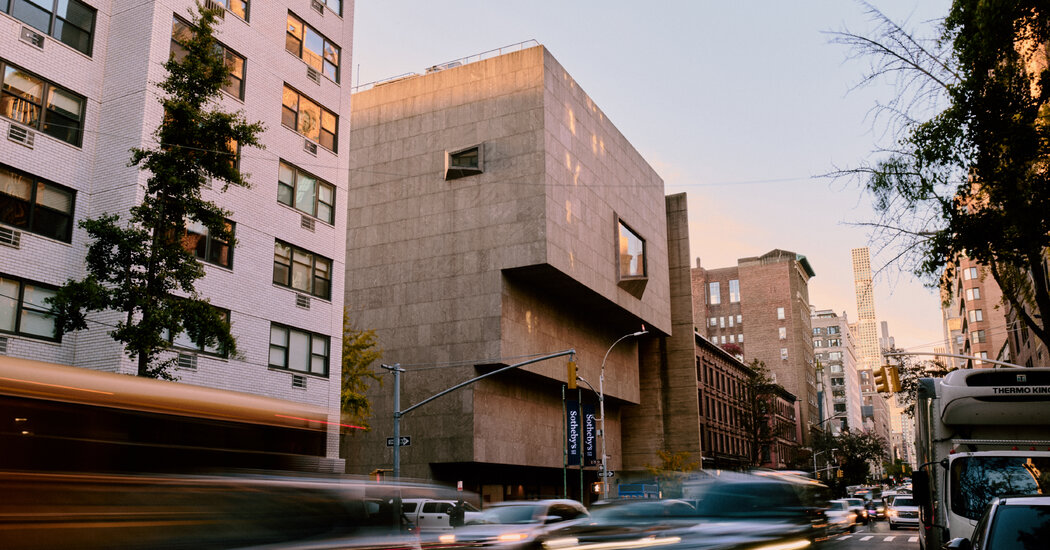Preservationists crossed their fingers when the auction house Sotheby’s bought the Whitney Museum of American Art’s former home on Madison Avenue a couple of years ago.
It’s Marcel Breuer’s brooding, magnificent upside-down ziggurat, looming over the corner of 75th Street on the Upper East Side.
After a revamp by the New York office of Herzog & de Meuron, the storied Swiss architecture firm, the Brutalist building from 1966 is reopening on Nov. 8 as Sotheby’s new headquarters. Before the sale, rumors were flying in excitable art and architecture circles that the Whitney might sell to a store or a gazillionaire who planned to turn the inside into a McMansion.
So the $100 million purchase by Sotheby’s, whose business is, after all, selling art (which it exhibits), came as a relief, but it wasn’t clear how the auction house would tinker.
Now we know. Thankfully little, is the answer. Mostly surface change. The renovation is thoughtful and deeply respectful, with a stress on materiality and crisp detail that is typical of Herzog & de Meuron.
The irony will not be lost on New York City architects and historians of a certain vintage.
“The most disliked building in New York,” is how Ada Louise Huxtable, the New York Times’s former architecture critic, summarized public opinion about Breuer’s museum when it opened.
It is a gray granite fortress whose concrete walls on the east and south sides of the museum quarantine the Whitney from buildings next door. The stepped-cantilever facade retreats from Madison Avenue behind a dry moat, as if assuming a defensive posture in the neighborhood.
Authors of the 1967 “A.I.A. Guide to New York” pictured boiling oil being spilled from the Whitney’s Cyclopean window on visitors fording the concrete bridge that Breuer designed to cross the moat.
Yet the museum, with its height and massing, also presented itself a little like a sheepish linebacker hunching into a Spirit Airlines seat. An unmissable presence, it attempted not to stand out too much. And for all its opacity, it rested on a cinched ground floor whose windows nodded to storefronts along Madison Avenue.
Beyond the exterior, the lobby of slate, stone and bush-hammered concrete was a cocoon of cool, understated luxury and sculptural finesse. Its scale was intimate. Over time, many New Yorkers came to admire the building. In the early 1980s it was designated a city landmark.
That was a twist, too. In 1978 Breuer precipitated a U.S. Supreme Court ruling that reshaped America probably more than any other land-use decision in the modern history of the court.
The Penn Central Transportation Company, which owned Grand Central Terminal, had wanted to erect an office tower on top of the terminal. The city’s Landmarks Preservation Commission, then still young, blocked the plan. Penn Central sued.
The Supreme Court upheld New York City’s preservation law, and since then all 50 states and more than 500 municipalities have enacted their own preservation laws.
The architect of that over-the-top tower proposal to put a skyscraper on Grand Central Terminal?
Marcel Breuer.
What goes around, as they say. Less than a decade after the Supreme Court ruling, the Whitney decided to mess with Breuer’s building. Preservationists who opposed Breuer’s Grand Central scheme rallied to his Whitney’s defense.
The museum had expanded its collection and programs. Whitney officials deemed the building too small and hired the Princeton architect Michael Graves to imagine an expansion. His three Postmodern proposals swallowed Breuer’s architecture in collages of cartoonishly classicizing additions.
When those plans met with understandable resistance, Graves was replaced by Rem Koolhaas, who designed a fantastical armature engineered by Ove Arup that would rise above the brownstones next door like a concrete Godzilla. Renzo Piano then suggested swapping Godzilla for a midrise tower tucked discreetly behind the brownstones, which didn’t add enough space.
Finally the Whitney decided to quit Madison Avenue entirely and moved in 2015 into a new, larger Piano building vaguely shaped like an ocean liner shipwrecked in the meatpacking district. For the next eight years, Whitney officials rented out Breuer’s masterpiece while they pondered what to do with the building.
This was when the penny dropped, I think, for many more New Yorkers and others. The Met, then the Frick Collection, leased the building to put on exhibitions and display their collections. Seeing the Frick’s Rembrandts and Titians there made both the art and Breuer’s abstraction suddenly look fresh.
Herzog & de Meuron has now steam-cleaned his gorgeous walls. Some of the galleries that Breuer designed, which had been closed to the public to squeeze in offices and other back-of-house spaces, have been converted back to galleries. The rooms are reorganized, flexible and white. Axial views of Breuer’s trapezoidal, gun-port windows are restored.
A fifth floor mezzanine has been turned into a skybox where V.I.P. clients can now gaze down on live auctions from behind a wall of smartly mirrored glass. (It is akin to the mirrors at the new Calder Gardens in Philadelphia, which dematerialize the building’s entrance.)
Sleek vitrines have been added to some of Breuer’s built-in lobby furniture; they may be jarring at first sight to anyone accustomed to the lobby from the old days, but, like the skybox, they try not to be conspicuous and they’re reversible.
The one major structural alteration is a service elevator on the north end of the building, which steals a slice of original gallery space but adds a crucial feature for a company that moves an incredible amount of art. The elevator isn’t anything that anyone who isn’t privy to Sotheby’s behind the scenes will notice. But it will whisk those V.I.P.s. to the skybox.
That’s pretty much it.
PBDW Architects, collaborators with Herzog & de Meuron on other local projects including the Park Avenue Armory, were architects of record on the renovation, coordinating alterations with the Landmarks Commission.
The biggest change in the end is that entry to the building will now be free, unlike when this was a ticketed museum. At Sotheby’s, the art is for sale but anyone can just walk in to peruse it.
Looking back, it’s easy to say New York avoided architectural hara-kiri with those expansion plans, although I sometimes wonder whether Koolhaas’s swashbuckling proposal might have been, like Breuer’s design, something New Yorkers could have come to appreciate.
We’ll never know. Preservation is always as much a gamble as change.
It’s the classic love story arc. We can’t stand a work of architecture until we go the mat not to lose it.
Michael Kimmelman is The Times’s architecture critic and the founder and editor-at-large of Headway, a team of journalists focused on large global challenges and paths to progress. He has reported from more than 40 countries and was previously chief art critic.
The post Once Hated, Now Loved, a Brutalist Behemoth Gets a Makeover appeared first on New York Times.




